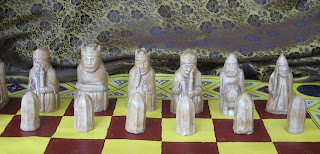Chess is widely believed to have developed as the game “Chaturanga,” a Sanskrit word meaning “four arms.” Appearing around the sixth century, Chaturanga was a means of teaching strategy to Indian nobility. The game appears to have been played with figural pieces representing the four major branches of a complete army--the foot soldiers (pawns), the cavalry (knights), chariots (rooks--I will explain this in a minute) and of course, elephants (bishops--I’ll explain this soon as well).
 |
| Reproductions of Persian chess pieces ca. 1000. | |
|
With time the game was brought along trade routes to China and Persia. In Persia it came to be called “Shatranj.” It was again seen as a game for nobility and elites. In Persia Shatranj pieces were abstract in style because of prohibitions in Islam against depicting living beings. Through trade with Europe shatranj made its way across northern Africa and was brought into Europe through the Iberian peninsula and across Europe, including
Britain and Scandinavia. The date for its arrival in Europe is believed to be around 700-800 AD, and it probably reached Scandinavia and Britain around 1100 AD. Chess, as it was now called, caught on quickly and replaced other board games such as various forms of tafl, a strategy game common in northern Europe.
 |
| Reproductions of the Lewis chessmen. |
For centuries Europeans retained the abstract Persian style of pieces, but figural pieces gradually became more common. The most notable example is the Lewis chessmen, discovered around 1831 on the remote Isle of Lewis in the Hebrides in Scotland. These pieces, representing foot soldiers, knights, bishops, queens and kings, have been reproduced countless times.
The original designation for chess pieces was different than today. Pawn, knight, and king were the same as today. The rook was originally a chariot, and the word “rook” (“rukh” in Persian) is a reminder of that. The rook, originally a square piece with a wedge cut out of the top became a castle. The elephant became the bishop because there were no elephants in Europe and elephants had ceased to be used in warfare, along with chariots. The Persian piece somewhat resembled a bishop’s mitre, so they became bishops.
 |
| The Charlemagne set. The kings are over five inches tall! |
The queen is the most notable transformation. In the Indian and Persian versions the piece next to the king was the vizier or general. It did not become the queen until the game had been in Europe several centuries. It remained the weakest piece on the board until the late 1400’s when the bishop and queen took on their present-day moves.
 |
| The troops advance and face off. |
Before the Lewis chessmen, which were made around 1150 in Norway, there was the Charlemagne chess set. This set, the remainders of which are in a museum in Paris, date from around 1050. Carved from single pieces of elephant ivory, these massive pieces comprise a chess set intended for royalty or high nobility. The workmanship is superior and the effect is unmistakable.
Several years ago I decided to reproduce this set making the reproduction pieces full size. Ivory is no longer available, nor should it be, and I wouldn’t be able to afford it if it were, so I decided to form the pieces using Sculpey, a polymer clay that is baked to harden it. Several evenings a week for a month or so I worked on these pieces, forming them as best as I could.
If I don’t mind saying so myself, the result was worth the effort. I’ve gotten many compliments on this set at SCA events. I have led classes in medieval chess at a number of events, and I try to reserve the huge Charlemagne set for younger children, if there are any in the class. It has been a delight to see 8 or 9 year old kids playing chess with pieces that are almost too big for them to pick up with one hand. It’s quite a thrill for them.
To sit and reflect on the Charlemagne set is an interesting experience. It brings the game to life, but is also reminds me of the brutal nature of war






















